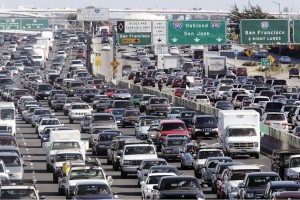Traffic congestion costs American motorists an average of $1,200 per year, according to the Global Traffic Scorecard from INRIX, a leader in transportation analytics and connected car services.
The study also described Los Angeles as the metropolitan area in the U.S. with the worst congestion. New York and San Francisco came in second and third respectively on the INRIX index, followed by Atlanta, Miami, Washington D.C. and Dallas.
Boston, Chicago and Seattle round out the list of top 10 most congested metropolitan areas, according to INRIX.
“A stable U.S. economy, continued urbanization of major cities, and factors such as employment growth and low gas prices have all contributed to increased traffic in 2016,” said Bob Pishue, senior economist at INRIX.
“Congestion also costs our country hundreds of billions of dollars, threatens future economic growth and lowers our quality of life. Traffic truly is a double-edged sword.
“The demand for driving is expected to continue to rise, while the supply of roadway will remain flat. Using big data and technology to improve operations of existing roadways offers a more immediate impact on traffic flows and mobility while transportation officials explore strategic capital investments,” he said.
(Delinquent car loans reach all-time highs. Click Here for the story.)
INRIX analyzed traffic in 1,064 cities – 240 in the U.S. – across 38 countries, making it the largest ever study of traffic congestion. It also used some new methodology and based on the findings, the U.S. ranked as the first most congested developed country in the world, with drivers spending an average of 42 hours a year in traffic during peak hours.
For the first time, the INRIX Traffic Scorecard also includes the direct and indirect costs of congestion to all U.S. drivers, which amounted to nearly $300 billion in 2016, an average of $1,400 per driver.
U.S. cities dominated the top 10 most congested cities globally, with Los Angeles in first place, New York in third, San Francisco ranked fourth, Atlanta eighth and Miami 10th.
Los Angeles commuters spent an average of 104 hours last year in traffic jams during peak congestion hours – more than any other city in the world.
(Click Here for more about 2016 auto sales.)
This contributed to congestion costing drivers in Los Angeles $2,408 each and the city as a whole $9.6 billion from direct and indirect costs. Direct costs relate to the value of fuel and time wasted, and indirect costs refer to freight and business fees from company vehicles idling in traffic, which are passed on to households through higher prices.
Interestingly, both New York and San Francisco, the second- and third-ranked cities in North America with 89 and 83 peak hours spent in congestion respectively, have a similar average congestion rate – 13% – as Los Angeles, but show strikingly different traffic patterns during various parts of the day.
For example, New York City has the highest daytime congestion on arterials and city streets, while San Francisco holds the top spot at peak times.
Phoenix and Detroit tie for the lowest cost of congestion among the top 25 U.S. cities, at $1,062 per driver, and rank among the bottom in all three categories of costs: commuting, business and leisure/other.
(Leasing levels surge, raise concern. Click Here to see why.)
Despite the high costs of congestion in New York and other cities, American drivers, in general, have it easier than their German counterparts. At $1,938, congestion costs the average German driver 38% more than an American, after adjusting for exchange rates and the cost of living.



This is a high time to realize the importance of nature and controlling vehicle as it is increasing pollution. Not just congestion.